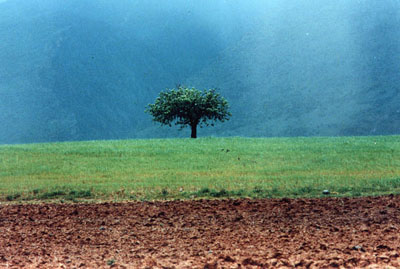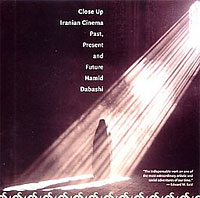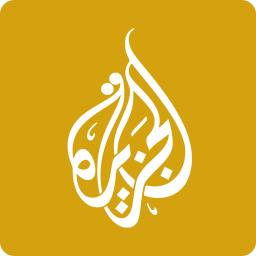
A Photograph by Abbas Kiarostami
The history of cinema in Iran cannot be read in isolation with its political and social development that can be traced as far back as 1906 when the constitutional and subsequently bourgeois revolution rocked the whole internal nature of the country. The discovery of oil, followed by the country’s entrance to the age of global capitalism, through a colonising presence with the British and Russian occupation during the First World War, and the formation of the Iranian communist party shortly after, are all aspects of a jigsaw puzzle that can help explain the journey of Iranian cinema, as well as its potency as a medium today.
Pre-cinema, the most significant forms of artistic expression in Iran were modern literature and poetry that found their own aesthetic space beyond the colonially controlled modernity that defined the time. Photographic representation and fine art were then confined to the royal court. Even though the history of film watching can be traced back to as early as 1904, cinema had not yet found its national language, emerging later as a populist art form taking the place of public storytelling (Naqqali). Interestingly enough it was in fact the Armenians, Jews and Zoroastrians that were initially responsible for introducing cinema to the Iranian public of the 1930s, and not surprisingly from the start there was religious opposition to the medium, due to its very nature that is ultimately against Islamic principals.
Most significant to the history of Iranian cinema was perhaps the coming to power of Reza Shah in 1926 and a forced modernisation programme, which lead to mass urbanisation. The new urban dwellers needed a new form of entertainment hence a whole wave of silent films emerged in the 1930s with movie houses packed with this new generation of city dwellers. Also significant was the following wave of terror under the Shah and his notorious political prisons. Notable was the banning of an old traditional Iranian performing art, Ta’ziyeh. Deemed anti-establishment, it went underground emerging only later under the Islamic regime.
The American military occupation of Iran in 1942 followed by the CIA-engineered coup against Mosaddiq in 1953 brought with it a new social political awareness very different to that of Europe. Under the young Shah, cinema became a commercial commodity. Numerous production houses were set up making films that mainly depicted the emergence of an educated middle class. Additionally the concept of nationalism emerged in Iranian films. However Filmfarsi did not attract a mass audience who were wooed by the glamour of Hollywood and Bollywood imports. Instead it was through modern poetry and fiction that secular intellectuals found a voice of opposition to the governing dictatorship.
Cinema’s power as an art form only saw light in the 1960s. By then Iranians were exposed to the best of world cinema, which had a major impact on the more social-realist films of the period. Most significantly were Forough Farrokhzad’s The House is Black (Khaneh Siyah Ast), and Farrokh Gaffari’s the Night of The Hunchback (Shab-e Ghuzi), both major influences on films of the 1980s and 1990s. But perhaps most symbolic to that period was Daryush Mehrju’i’s 1969 masterpiece The Cow (Gav) that transformed the definition of Iranian cinema and gave it an entirely unique visual language.
By the 1970s opposition to the Pahlavi regime was in full swing. Amir Naderi’s Tangsir reflected the anti-establishment feeling in the air and in particular was a critic of the brutal suppression of the Siyahkal guerrilla movement. Sohrab Shahid Sales’ One Simple Incident (Yek Ettefaq-e Sadeh) introduced a whole new way of looking at reality and the formation of a unique form of realism. In the period that followed, cinema became an important window — and has remained even more so — to a modernity that Iranians could only partially experience.
The world changed for Iran and its intellectuals, poets, writers and filmmakers in 1979 when Mohammad-Reza Shah was forced into exile and the revolution took a turn that allowed for Ayatollah Khomeini’s reign and the formation of the Islamic Republic of Iran. This was shortly followed by the Iran-Iraq war and a brutal suppression of anyone with beliefs against the new regime. Women were once again veiled and most secular intellectuals fled the country. It was an altogether uncreative time for most artists and cinema became a tool solely for the government’s propaganda. The Iranian new wave cinema was born into this vacuum. Its success has since been universal, not only for the films, but also for some of its directors who have become world celebrities.
Hamid Dabashi begins his venture with a brief, but thorough look at Iranian social political history as well as a quick glance at other art forms that existed alongside cinema. The chapter is significant in that it creates an initial insight that is not only crucial in the latter understanding of Iranian cinema, but also useful for non-Iranian readers who are perhaps less familiar with the history. It does also prepare you for a rich journey into a vast jungle of information and data gathered in Close Up: Iranian Cinema. Dabashi employs interviews with directors, insightful commentary on individual films, and an extensive filmography, to create a well-directed journey through the development of Iranian cinema.
We are first introduced to probably the most famous Iranian cinematic export, Abbas Kiarostami, with a chronological look at his work pre and post-revolution. Second on the list is director Bahram Beiza’ i, again an active pre-revolutionary director. We gain an insightful glimpse into his work through an interview Dabashi conducted in the US in 1995, followed by a comprehensive analysis of the director’s major films. The author sees Beiza’ i as one of the founders of the modern movement in Iranian cinema. In an engaging conversation Dabashi deliberately engages Beiza’ i in the subject of myth and mythology as to argue what he thinks is central to the director’s beliefs, that he “remythologises Iranian culture”. For his next move, Dabashi introduces veteran director Bahman Farmanara, a very different choice to the previous two. Farmanara left Iran after the revolution, returning some 20-odd years on to make a film that Dabashi argues has been important to the development of modern Iranian cinema. Again using a Q&A format the reader seems to gain much better insight into the life of Farmanara than we have so far with the others.
However it is in the fifth chapter that things really begin to heat up. Here Dabashi puts down on paper – exactly as transcribed it seems – a conversation he had with controversial director Mohsen Makhmalbaf in New York in 1996, at the very height of his popularity. It seems that the author has deliberately allowed his subject to air his views. Makhmalbaf’s account is as much about his colourful life, and his transforming ideology as it is about his work. Dabashi successfully allows for the interview to take its natural course, only at times egging his subject on or challenging his thoughts. Interestingly enough it is only later on in the book that we realise Dabashi’s familiarity and perhaps friendship with Makhmalbaf.
Next the author touches on a very significant and often ignored subject of women in Iranian cinema. Here another maverick director, Rakhshan Bani-Etemad’s documentary style social realist work is introduced in more detail. In a significant analysis of her cinema, Dabashi argues that her “subversive jolting of sexuality is something exclusive to her cinema,” which he sees as pathologically absent from the work of her male counterparts. He notes that it is only after reading this “feminine gaze” that it becomes transparent that the men wish to remodel the real.
In the final chapter the author explores concepts of globalisation and its effect on Iranian cinema. The journey first takes us to Tehran where the author believes old masters are ageing gracefully, then to Cannes where the new ones are creating fresh visions. Potent to Dabashi’s argument is what he refers to as the “graceful rise of a new generation who see the world from the material basis of their organic roots in reality”. This as a transition from the older generation, whose world was a reflection of their creative ego, marks the moment of rapid globalisation of Iranian cinema. Here Dabashi puts Kiarostami on the stand and with a clever interrogation of his work, deconstructs many of the myths surrounding the famous director. Dabashi sees Kiarostami’s success a result of the “unobtrusive corner in which his camera is positioned.” He notes that the director’s story has been the spectacular success story of a Third World filmmaker who has universalised his native location, restoring a dignity to its people. However this aspect, since global recognition, has been lost from his cinema. As for Beiza’i, our author sees him as being left behind from the globality of our condition, turning into a museum piece and in a sense “museumising” his own culture.
This is where Dabashi sees the importance of the new generation of filmmakers in beating this museumisation. He says if those who control the elite European film festivals continue to favour the aggressive exoticisation of the Third World, thus becoming the cinematic version of the National Geographic, then it will have catastrophic consequences. On the other hand if the films chosen were to have a public function beyond the festivals, the nativism needs to posses a critical awareness of globality. The author does not see the older generation responding well to this globalisation, but the younger ones — or the ‘children of the Revolution’ — are subconsciously part of this globalised world and this is naturally reflective in their creative eye.
Which brings us to Dabashi’s last three subjects: Samira Makhmalbaf, Hasan Yektapanah and Bahman Qobadi. These directors are significantly from the fringes of Iranian society, something that would have been impossible under the previous regime. The most famous of the three, Makhmalbaf is a woman, Yektapanah an Afghani Iranian and Qobadi’s an Iranian Kurd. Their collective marginality is in fact crucial to the power of their films. This is a post-ideological generation that Dabashi sees, in its defiance of the institutional foregrounding of abstract idealism, reaching for a kind of “virtual realism”. The only one from the older generation with a similar naturalism is perhaps Makhmalbaf senior.
Dabashi argues that the power of cinema has proceeded that of literature in that it has become an international art, with wide global viewing. Accordingly the Iranian cinema is so powerful because Iranians have watched and assimilated the world through film. Now the cinema is reflecting back to the world what it has seen, adding its own cultural colour. Additionally its power stems from the fact that the world had made up its mind about Iran through images and news reports following the revolution, and was therefore perhaps a little surprised by what it saw on the screen. Dabashi goes further to say: “In the cinema we were re-born as global citizens in defiance of the tyranny of the time and the isolation of the space that sought to confine us.” In a sense cinema is a glimpse into the hopes and desires of a nation.
Close Up is a successful fusion of art, politics and social history, with cinema placed successfully in a global context. Dabashi’s choice of subject matters are interesting in that they are all from very different social, economic, political and ideological backgrounds and so in a sense each offers a branch of what makes present Iranian cinema. There is more than one way to interpret history and in this case cinema has been used to tell the story of modern Iran. As Dabashi says: “The history of modern Iranian cinema is as much a record of that failure [that of the project of modernity] as a wish list for its successes. At its best, this cinema has succeeded in re subjecting the Iranian self where the project of modernity has failed.”
(From Nargess Shahmanesh-Banks’ review of Close Up: Iranian Cinema, Past, Present, Future, at Iran Bulletin, available at www.iran-bulletin.org)



 Columbia University
Columbia University Aljazeera
Aljazeera Middle East Eye
Middle East Eye Springer Palgrave
Springer Palgrave